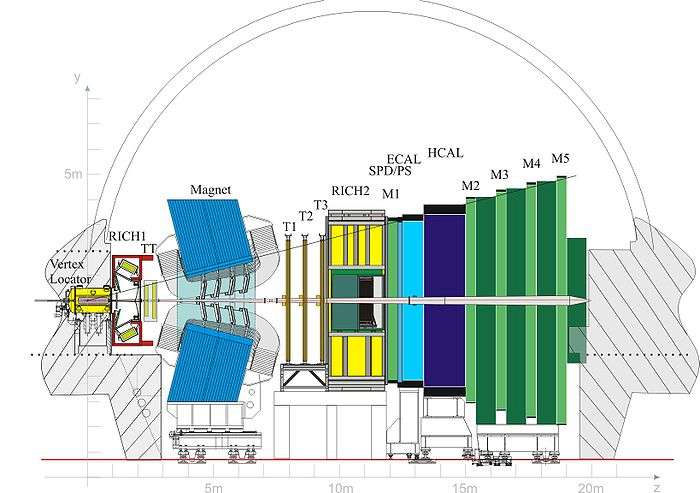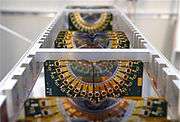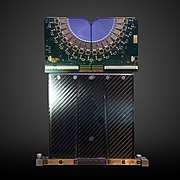LHCb experiment
The LHCb (Large Hadron Collider beauty) experiment is one of eight particle physics detector experiments collecting data at the Large Hadron Collider at CERN. LHCb is a specialized b-physics experiment, designed primarily to measure the parameters of CP violation in the interactions of b-hadrons (heavy particles containing a bottom quark). Such studies can help to explain the matter-antimatter asymmetry of the Universe. The detector is also able to perform measurements of production cross sections, exotic hadron spectroscopy, charm physics and electroweak physics in the forward region. The LHCb collaboration, who built, operate and analyse data from the experiment, is composed of approximately 1260 people from 74 scientific institutes, representing 16 countries.[1] Chris Parkes[2] succeeded on July 1, 2020 as spokesperson for the collaboration to Giovanni Passaleva (spokesperson 2017-2020).[3] The experiment is located at point 8 on the LHC tunnel close to Ferney-Voltaire, France just over the border from Geneva. The (small) MoEDAL experiment shares the same cavern.
 | |
| LHC experiments | |
|---|---|
| ATLAS | A Toroidal LHC Apparatus |
| CMS | Compact Muon Solenoid |
| LHCb | LHC-beauty |
| ALICE | A Large Ion Collider Experiment |
| TOTEM | Total Cross Section, Elastic Scattering and Diffraction Dissociation |
| LHCf | LHC-forward |
| MoEDAL | Monopole and Exotics Detector At the LHC |
| FASER | ForwArd Search ExpeRiment |
| LHC preaccelerators | |
| p and Pb | Linear accelerators for protons (Linac 2) and Lead (Linac 3) |
| (not marked) | Proton Synchrotron Booster |
| PS | Proton Synchrotron |
| SPS | Super Proton Synchrotron |
Physics goals
The experiment has wide physics program covering many important aspects of heavy flavour (both beauty and charm), electroweak and quantum chromodynamics (QCD) physics. Six key measurements have been identified involving B mesons. These are described in a roadmap document[4] that form the core physics programme for the first high energy LHC running in 2010–2012. They include:
- Measuring the branching ratio of the rare Bs → μ+ μ− decay.
- Measuring the forward-backward asymmetry of the muon pair in the flavour-changing neutral current Bd → K* μ+ μ− decay. Such a flavour changing neutral current cannot occur at tree-level in the Standard Model of Particle Physics, and only occurs through box and loop Feynman diagrams; properties of the decay can be strongly modified by new Physics.
- Measuring the CP violating phase in the decay Bs → J/ψ φ, caused by interference between the decays with and without Bs oscillations. This phase is one of the CP observables with the smallest theoretical uncertainty in the Standard Model, and can be significantly modified by new Physics.
- Measuring properties of radiative B decays, i.e. B meson decays with photons in the final states. Specifically, these are again flavour-changing neutral current decays.
- Tree-level determination of the unitarity triangle angle γ.
- Charmless charged two-body B decays.
The LHCb detector
The fact that the two b-hadrons are predominantly produced in the same forward cone is exploited in the layout of the LHCb detector. The LHCb detector is a single arm forward spectrometer with a polar angular coverage from 10 to 300 milliradians (mrad) in the horizontal and 250 mrad in the vertical plane. The asymmetry between the horizontal and vertical plane is determined by a large dipole magnet with the main field component in the vertical direction.


Subsystems
The vertex detector (VELO) is built around the proton interaction region.[5][6] It is used to measure the particle trajectories close to the interaction point in order to precisely separate primary and secondary vertices.
The detector operates at 7 millimetres (0.28 in) from the LHC beam. This implies an enormous flux of particles; The VELO has been designed to withstand integrated fluences of more than 1014 p/cm2 per year for a period of about three years. The detector operates in vacuum and is cooled to approximately −25 °C (−13 °F) using a biphase CO2 system. The data of the VELO detector are amplified and read out by the Beetle ASIC.
 The vertex locator (VELO) during construction.
The vertex locator (VELO) during construction. One element of VELO
One element of VELO
The RICH-1 detector (Ring imaging Cherenkov detector) is located directly after the vertex detector. It is used for particle identification of low-momentum tracks.
The main tracking system is placed before and after the dipole magnet. It is used to reconstruct the trajectories of charged particles and to measure their momenta. The tracker consists of three subdetectors:
- The Tracker Turicensis, a silicon strip detector located before the LHCb dipole magnet
- The Outer Tracker. A straw-tube based detector located after the dipole magnet covering the outer part of the detector acceptance
- The Inner Tracker, silicon strip based detector located after the dipole magnet covering the inner part of the detector acceptance
Following the tracking system is RICH-2. It allows the identification of the particle type of high-momentum tracks.
The electromagnetic and hadronic calorimeters provide measurements of the energy of electrons, photons, and hadrons. These measurements are used at trigger level to identify the particles with large transverse momentum (high-Pt particles).
The muon system is used to identify and trigger on muons in the events.
Results
During the 2011 proton-proton run, LHCb recorded a luminosity of 1 fb−1 at an energy of 7 TeV. In 2012, about 2 fb−1 was collected at an energy of 8 TeV.[7] These datasets allow the collaboration to carry out the physics program of precision Standard Model tests with many additional measurements. The analysis led to evidence for the flavour-changing neutral current decay Bs → μ μ.[8] This measurement impacts the parameter space of supersymmetry. A combination with Compact Muon Solenoid (CMS) data from the completed 8 TeV run allowed for a precise measurement of the strange b-meson to dimuon branching fraction. CP violation was studied in various particle systems such as Bs, Kaons, and D0.[9] New Xi baryons were observed in 2014.[10] Analysis of the decay of bottom lambda baryons (Λ0
b) in the LHCb experiment also revealed the apparent existence of pentaquarks,[11][12] in what was described as an "accidental" discovery.[13]
References
- "LHCb Organization".
- Ana Lopes (2020-06-30). "New spokesperson for the LHCb collaboration". CERN. Retrieved 2020-07-03.
- "Giovanni Passaleva". LHCb, CERN. Retrieved 2020-07-03.
- B. Adeva et al (LHCb collaboration) (2009). "Roadmap for selected key measurements of LHCb". arXiv:0912.4179 [hep-ex].
- , The LHCb VELO (from the VELO group)
- , VELO Public Pages
- "Luminosities Run1". Retrieved 14 Dec 2017., 2012 LHC Luminosity Plots
- R Aaij et al. (LHCb collaboration) (2013). "First evidence for the decay Bs→μ+μ−". Physical Review Letters. 110 (2): 021801. arXiv:1211.2674. Bibcode:2013PhRvL.110b1801A. doi:10.1103/PhysRevLett.110.021801. PMID 23383888.
- "ArXiv Search".
- "LHCb experiment observes two new baryon particles never seen before". 19 Nov 2014.
-
"Observation of particles composed of five quarks, pentaquark-charmonium states, seen in Λ0
b→J/ψpK− decays". CERN/LHCb. 14 July 2015. Retrieved 2015-07-14. -
R. Aaij et al. (LHCb collaboration) (2015). "Observation of J/ψp resonances consistent with pentaquark states in Λ0
b→J/ψK−p decays". Physical Review Letters. 115 (7): 072001. arXiv:1507.03414. Bibcode:2015PhRvL.115g2001A. doi:10.1103/PhysRevLett.115.072001. PMID 26317714. - G. Amit (14 July 2015). "Pentaquark discovery at LHC shows long-sought new form of matter". New Scientist. Retrieved 2015-07-14.
External links
- LHCb Public Webpage
- LHCb section from US/LHC Website
- A. Augusto Alves Jr. et al. (LHCb Collaboration) (2008). "The LHCb Detector at the LHC". Journal of Instrumentation. 3 (8): S08005. Bibcode:2008JInst...3S8005T. doi:10.1088/1748-0221/3/08/S08005. hdl:10251/54510. (Full design documentation)